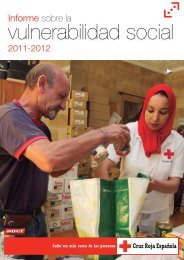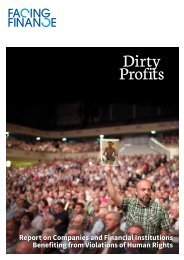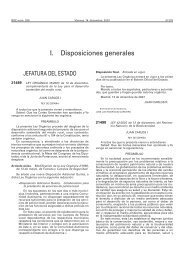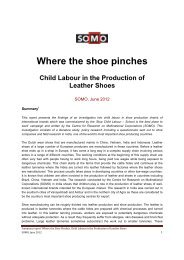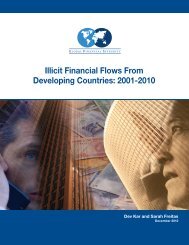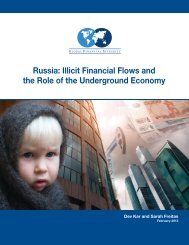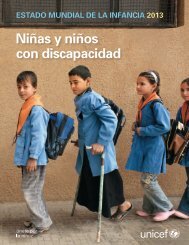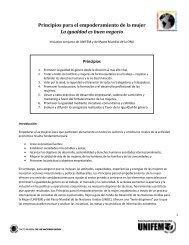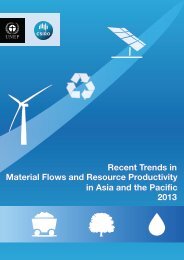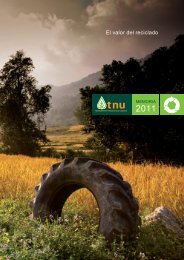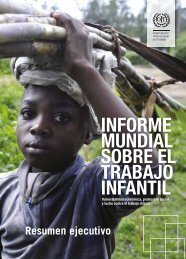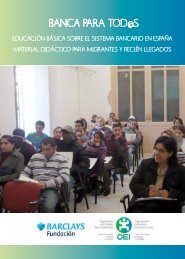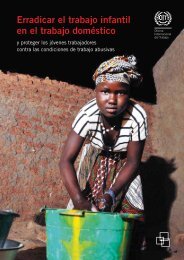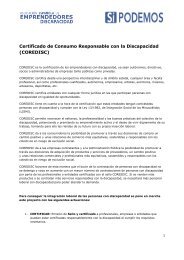Dow Jones Sustainability Emerging Markets Index Guide - Spainsif
Dow Jones Sustainability Emerging Markets Index Guide - Spainsif
Dow Jones Sustainability Emerging Markets Index Guide - Spainsif
- No tags were found...
You also want an ePaper? Increase the reach of your titles
YUMPU automatically turns print PDFs into web optimized ePapers that Google loves.
<strong>Dow</strong> <strong>Jones</strong> <strong>Sustainability</strong> <strong>Emerging</strong><strong>Markets</strong> <strong>Index</strong> <strong>Guide</strong>Version 1.021 February 2013RobecoSAM AGJosefstrasse 218 - 8005 Zurich - Switzerland - www.robecosam.com - Phone +41 44 653 18 00 - Fax +41 44 653 18 10
1. Introduction to the <strong>Dow</strong> <strong>Jones</strong> <strong>Sustainability</strong> <strong>Emerging</strong> <strong>Markets</strong> <strong>Index</strong> 42. <strong>Dow</strong> <strong>Jones</strong> <strong>Sustainability</strong> <strong>Emerging</strong> <strong>Markets</strong> <strong>Index</strong> 52.1 Composite <strong>Index</strong> 52.2 Customized Indices 53. Corporate <strong>Sustainability</strong> Assessment 63.1 Concept 63.2 Methodology 63.3 Criteria Definition and Weightings 83.4 Total <strong>Sustainability</strong> Score 104. Media and Stakeholder Analysis 114.1 Concept 114.2 MSA Monitoring Process 115. <strong>Index</strong> Features & Data Dissemination 135.1 DJSI <strong>Emerging</strong> <strong>Markets</strong> Eligible Universe 135.2 Sector Classification 135.3 Supersector Classification 145.4 Base Date & Base Value 155.5 Currency Rates 155.5.1 US dollar denominated indices: 155.5.2 Closing currency rates: 155.6 <strong>Index</strong> Dissemination Period 155.7 <strong>Index</strong> Calculation 155.8 Stock Prices 155.8.1 Official closing stock prices: 155.8.2 Suspended quotations: 155.8.3 Stock exchange holidays: 155.9 Day-End Dissemination 165.10 Dividend Treatment 165.11 Weightings 165.12 <strong>Index</strong> Divisors 165.13 Review, Implementation & Effective Dates 175.14 Historical <strong>Index</strong> Values 175.15 Data Vendor Codes 175.16 Publications 176. Annual and Quarterly Reviews 186.1 Annual Review 186.1.1 Quarterly Review 186.1.2 Communication of changes 186.2 Investable Stocks Universe 186.3 Annual Selection DJSI <strong>Emerging</strong> <strong>Markets</strong> 196.3.1 Industry Group Classification: 196.3.2 Corporate <strong>Sustainability</strong> Assessment: 196.3.3 Sector Ranking: 196.3.4 Eligible Sectors: 192 / 31
6.3.5 Eligible Companies: 196.3.6 Component Selection: 197. Ongoing Maintenance 207.1 Changes in the Total <strong>Sustainability</strong> Score 207.2 Changes due to Initial Public Offerings (IPOs) 207.3 Changes due to Spin-Offs 207.4 Changes due to Mergers & Takeovers 217.4.1 Component & component (acquisition target and acquirer are both index components): 217.4.2 Component & non-component (acquisition target or acquirer is an index component): 217.5 Changes due to Sector Classifications 237.6 Changes to Weightings 237.7 Changes to Liquidity 238. Calculation Model 238.1 Input Data Specification 238.2 Input Data Monitoring 238.3 Input Data Corrections 248.4 <strong>Index</strong> Formula 248.5 Data Accuracy 248.6 <strong>Index</strong> Divisor Adjustments 258.7 <strong>Index</strong> Divisor Corrections 279. <strong>Index</strong> Management & Responsibilities 279.1 DJSI <strong>Index</strong> Design Committee 279.2 Customer Service 2710. Advance notice of important changes to the <strong>Dow</strong> <strong>Jones</strong> <strong>Sustainability</strong> Indices (DJSI) 2810.1 Summary of index selection methodology changes 283 / 31
1. Introduction to the <strong>Dow</strong> <strong>Jones</strong> <strong>Sustainability</strong> <strong>Emerging</strong> <strong>Markets</strong><strong>Index</strong>The <strong>Dow</strong> <strong>Jones</strong> <strong>Sustainability</strong> <strong>Emerging</strong> <strong>Markets</strong> <strong>Index</strong> (DJSI <strong>Emerging</strong> <strong>Markets</strong>) was established inFebruary 2013 to track the performance of the region’s largest companies that lead the field in terms ofcorporate sustainability. These companies are assessed by RobecoSAM using the annual Corporate<strong>Sustainability</strong> Assessment (CSA). Eligible companies are encouraged to actively participate in theassessment. However, RobecoSAM reserves the right to apply the same assessment methodology to nonparticipatingcompanies from the eligible universe based on information available in the public domain.This way at least 50% of the free-float market capitalization per sector is assessed, ensuring a best-inclassselection can take place.Established in 1999, as the first ever family of global sustainability benchmarks, the <strong>Dow</strong> <strong>Jones</strong><strong>Sustainability</strong> Indices (DJSI) have become a reference point in <strong>Sustainability</strong> Investing. Launched as acollaboration between S&P <strong>Dow</strong> <strong>Jones</strong> Indices and RobecoSAM, the DJSI combine the experience of anestablished index provider with the expertise of a specialist in <strong>Sustainability</strong> Investing to provide investorswith objective benchmarks for managing their sustainability investment portfolios. Anchored by theresults of RobecoSAM’s annual Corporate <strong>Sustainability</strong> Assessment (CSA), the DJSI comprise global andregional benchmarks as well as subsets that allow investors to exclude certain sectors or createcustomized indices.The DJSI family uses a best-in-class approach to select sustainability leaders from across all industrysectors based on pre-defined sustainability criteria embedded in the CSA. Best-in-class means that:• no sector is excluded from the indices, with the most sustainable companies in each sectorselected for index membership• companies receive a Total <strong>Sustainability</strong> Score between 0 – 100 and are ranked against othercompanies in their industry• only the top 10 % of companies from each sector, based on their sustainability score, areincluded in the <strong>Dow</strong> <strong>Jones</strong> <strong>Sustainability</strong> <strong>Emerging</strong> <strong>Markets</strong> <strong>Index</strong>Therefore, companies must continually intensify their sustainability initiatives to be included or remain inthe index. A growing number of companies define inclusion in the DJSI as a corporate goal as it publiclyendorses their approach to addressing key sustainability issues on the basis of a structured and objectivecomparative analysis. As a result, the DJSI have evolved into an effective engagement platform bycreating vibrant competition for index membership among companies within the same industry.RobecoSAM’s approach is based on two guiding principles:• Sustainable business practices are critical to the creation of long-term stakeholder value in anincreasingly resource-constrained world• <strong>Sustainability</strong> factors represent opportunities and risks that competitive companies mustaddressRobecoSAM passionately believes that the integration of sustainability criteria into traditional financialanalysis helps us to evaluate companies’ quality of management and future performance potential. Thisin turn enables us to identify attractive investment opportunities that can generate long lasting value forour clients. In short, a focus on sustainability leads to better informed investment decisions.4 / 31
RobecoSAM’s Corporate <strong>Sustainability</strong> Assessment (CSA) forms the research backbone of the globallyrecognized <strong>Dow</strong> <strong>Jones</strong> <strong>Sustainability</strong> Indices. This has afforded us direct access to companies and theirbusiness practices, enabling us to build one of the world’s most extensive research databases oncorporate sustainability. Based on a rigorous and rules-based methodology, the CSA has set the industrystandard for identifying companies best equipped to recognize and respond to emerging opportunitiesand risks resulting from global sustainability trends.RobecoSAM’s parent company is Dutch asset manager Robeco, which was established in 1929 and offersa broad range of investment products and services worldwide. RobecoSAM was founded in 1995, isheadquartered in Zurich and employs approximately 110 specialist staff.RobecoSAM partners with S&P <strong>Dow</strong> <strong>Jones</strong> Indices to develop and license the DJSI family, launched inSeptember of 1999. The DJSI family has since grown to include global, regional and country benchmarks.S&P <strong>Dow</strong> <strong>Jones</strong> Indices LLC, a subsidiary of The McGraw-Hill Companies, is the world's largest, globalresource for index-based concepts, data and research. Home to iconic financial market indicators, S&P<strong>Dow</strong> <strong>Jones</strong> Indices LLC has over 115 years of experience constructing innovative and transparent solutionsthat fulfill the needs of institutional and retail investors. S&P <strong>Dow</strong> <strong>Jones</strong> Indices offers over 830,000indices covering a wide range of assets classes across the globe, and more assets are invested in productsbased upon these indices than upon indices of any other provider.RobecoSAM selects the components, and jointly publishes and markets the DJSI with S&P <strong>Dow</strong> <strong>Jones</strong>Indices. S&P <strong>Dow</strong> <strong>Jones</strong> Indices is responsible for the index calculation and dissemination of the indexdata.2. <strong>Dow</strong> <strong>Jones</strong> <strong>Sustainability</strong> <strong>Emerging</strong> <strong>Markets</strong> <strong>Index</strong>The <strong>Dow</strong> <strong>Jones</strong> <strong>Sustainability</strong> <strong>Emerging</strong> <strong>Markets</strong> <strong>Index</strong> (DJSI <strong>Emerging</strong> <strong>Markets</strong>) tracks the performance ofthe top 10% of the 800 largest companies in 20 <strong>Emerging</strong> <strong>Markets</strong> in the <strong>Dow</strong> <strong>Jones</strong> Global Total StockMarket <strong>Index</strong>℠ that lead the field in terms of sustainability. These 800 companies represent the eligibleuniverse for the DJSI <strong>Emerging</strong> <strong>Markets</strong> and are assessed using the CSA on an annual basis.2.1 Composite <strong>Index</strong><strong>Dow</strong> <strong>Jones</strong> <strong>Sustainability</strong> <strong>Emerging</strong> <strong>Markets</strong> <strong>Index</strong> (DJSI <strong>Emerging</strong> <strong>Markets</strong>)2.2 Customized IndicesThe DJSI methodology facilitates the design, development and delivery of customized sustainabilityindices; e.g. indices covering regional or country subsets, indices covering different industry groups,indices that take ethical concerns into account, indices with custom exclusion criteria and indicesdenominated in different currencies.5 / 31
3. Corporate <strong>Sustainability</strong> Assessment3.1 Concept<strong>Sustainability</strong> is a company’s capacity to prosper in a hypercompetitive and changing global businessenvironment. Companies that anticipate and manage current and future economic, environmental andsocial opportunities and risks by focusing on quality, innovation and productivity will emerge as leadersthat are more likely to create a competitive advantage and long-term stakeholder value.3.2 MethodologyAs an investment boutique focused exclusively on sustainability investing, RobecoSAM has alwaysbelieved that financial analysis is incomplete if it ignores material extra-financial factors. <strong>Sustainability</strong>trends such as resource scarcity, climate change or an aging population continuously reshape acompany’s competitive environment. RobecoSAM is convinced that companies that can adapt to suchchallenges through innovation, quality and productivity enhance their ability to generate long-termshareholder value. For this reason, RobecoSAM developed the annual Corporate <strong>Sustainability</strong>Assessment (CSA) in 1999 in order to identify companies that are better equipped to recognize andrespond to emerging sustainability opportunities and challenges presented by global and industry trends.At least 50% of the questionnaire covers industry-specific risks and opportunities. This focus on industryspecificcriteria reflects RobecoSAM’s conviction that sector-specific sustainability opportunities and risksplay a key role in a company’s long-term success and allows RobecoSAM to compare companies againsttheir own peers in order to identify sustainability leaders. RobecoSAM’s CSA identifies the leadingsustainability companies within the DJSI <strong>Emerging</strong> <strong>Markets</strong> eligible universe from each RobecoSAMSector (for the sector classification see chapter 5.2).6 / 31
Figure 1 Structure of the RobecoSAM Corporate <strong>Sustainability</strong> AssessmentThe CSA is designed to capture both general and industry-specific criteria covering the economic,environmental and social dimensions. Each of the three dimensions consists of, on average 6 – 10criteria, and each criterion can contain between 2 – 10 questions, totaling approximately 80 – 120questions, depending on the sector. The criteria within each dimension roll up to the dimension weight.For each company, a Total <strong>Sustainability</strong> Score of up to 100 points is calculated based on the pre-definedweights established for each question and criterion (Figure 1). This Total <strong>Sustainability</strong> Score is used torank the company within its RobecoSAM Sector peer group to identify companies for inclusion in theindex. Information provided in the questionnaire is verified for accuracy by crosschecking companies’answers with the supporting documentation they have provided, checking publicly available information,and by verifying a company’s track record on crisis management with media and stakeholder reports. Inaddition, to ensure quality and objectivity of the CSA, independent third party Deloitte conducts anexternal audit of the assessment process each year.7 / 31
3.3 Criteria Definition and WeightingsBased on major global sustainability challenges identified by RobecoSAM’s analysts, general criteriarelating to standard management practices and performance measures such as Corporate Governance,Human Capital Development and Risk & Crisis Management are defined and applied to each of the 58RobecoSAM Sectors. The general criteria account for approximately 40 – 50% of the assessment,depending on the sector. At least 50% of the questionnaire covers industry-specific risks andopportunities that focus on economic, environmental and social challenges and trends that areparticularly relevant to companies within that industry. Figure 2 outlines examples of general vs. industryspecificcriteria for three different RobecoSAM Sectors in the 2011 CSA.Companies are evaluated based on a range of financially relevant sustainability criteria covering theeconomic, environmental and social dimensions. The relative weights of the economic, environmentaland social dimension of the questionnaire vary by industry. A company’s Total <strong>Sustainability</strong> Score at thehighest aggregated level is the sum of all question Scores. Each company receives a Total <strong>Sustainability</strong>Score ranging from 0 – 100. Once the Total Scores have been calculated, companies within the sameindustry are ranked against their peers in order to determine which companies are eligible for inclusion inthe DJSI <strong>Emerging</strong> <strong>Markets</strong>. The 58 RobecoSAM Sectors roll up into 19 global Supersectors, and the topscoring company from each is named the Supersector Leader and is profiled on the DJSI website.8 / 31
Figure 2 Comparison of criteria and relative dimension weights for the Banking, Electricity andPharmaceutical sectors (RobecoSAM Sectors) in 20119 / 31
3.4 Total <strong>Sustainability</strong> ScoreThe CSA generates a Total <strong>Sustainability</strong> Score for companies in the DJSI eligible universe. Thequestionnaire is designed to ensure objectivity by limiting qualitative answers through predefinedmultiple-choice questions in which each potential answer is assigned a number of points between 0 –100. For questions in which qualitative answers are allowed, RobecoSAM analysts evaluate the responseusing a predefined appraisal method, and convert the response into a quantitative score. An example ofhow the Questions are scored is depicted in Figure 3.Figure 3 Example of score calculation10 / 31
4. Media and Stakeholder Analysis4.1 ConceptAn integral component of the Corporate <strong>Sustainability</strong> Assessment is the ongoing monitoring of mediaand stakeholder commentaries and other publicly available information from consumer organizations,NGOs, governments or international organizations to identify companies’ involvement and response toenvironmental, economic and social crisis situations that may have a damaging effect on their reputationand core business.Throughout the year, RobecoSAM monitors news coverage of companies in the universe on a daily basisusing media stories compiled and pre-screened by RepRisk, a leading provider of media monitoring tools.News stories covered by the Media and Stakeholder Analysis (MSA) include a range of issues such aseconomic crime or corruption, fraud, illegal commercial practices, human rights issues, labor disputes,workplace safety, catastrophic accidents or environmental disasters.4.2 MSA Monitoring ProcessAn MSA “case” is created if a company has been the subject of a specific allegation that can harm itsreputation, resulting in financial consequences ranging from lost business, lost customers and decliningsales, to liabilities, litigation or fines. Such a case requires a reaction from the company in order toaddress the issue and minimize the negative impact of the crisis. In order to evaluate the quality of thecompany’s response to the situation, RobecoSAM continues to monitor news flow related to the incidentuntil it has been resolved.The MSA is built into the corporate sustainability assessment. For selected criteria within thequestionnaire, pre-defined weights have been set aside for potential MSA cases that may arise during theyear. The specific weight assigned to the MSA component will vary by criterion and by industry,depending on the materiality of the potential impact on the company. The chart in Figure 4 provides anoverview of how a specific MSA case is identified, evaluated and integrated into the CSA.11 / 31
Figure 4 Overview of MSA Process: From Identification to ResolutionThe results of the MSA can reduce a company’s Total <strong>Sustainability</strong> Score and thus affect its inclusion inthe <strong>Index</strong>. In addition, severe incidents and breaches that cast strong doubts on a company’s proceduresand ability to handle the situation can be escalated to the <strong>Dow</strong> <strong>Jones</strong> <strong>Sustainability</strong> Indices <strong>Index</strong> DesignCommittee (DJSI <strong>Index</strong> Design Committee) by the analyst. During the course of the MSA evaluation, theanalyst may contact companies to clarify any open points that may arise from the MSA case, thusallowing the analyst to include the company’s responses when making a recommendation. Following athorough analysis, the DJSI <strong>Index</strong> Design Committee may decide to change a company’s eligibilityimmediately, regardless of the company’s Total <strong>Sustainability</strong> Score.12 / 31
5. <strong>Index</strong> Features & Data Dissemination5.1 DJSI <strong>Emerging</strong> <strong>Markets</strong> Eligible UniverseIn order to compile an invitation list for the annual Corporate <strong>Sustainability</strong> Assessment, the DJSI<strong>Emerging</strong> <strong>Markets</strong> eligible universe is determined annually at the end of December. The DJSI <strong>Emerging</strong><strong>Markets</strong> eligible universe is derived from the assessment of the 800 largest listed companies from thefollowing 20 <strong>Emerging</strong> <strong>Markets</strong>: Brazil, Chile, China, Colombia, the Czech Republic, Egypt, Hungary,India, Indonesia, Malaysia, Mexico, Morocco, Peru, the Philippines, Poland, Russia, South Africa, Taiwan,Thailand and Turkey in terms of free float capitalization in the <strong>Dow</strong> <strong>Jones</strong> Global Total Stock Market<strong>Index</strong>℠. In addition, it consists of all current DJSI <strong>Emerging</strong> <strong>Markets</strong> components (as of end of Decemberof the preceding year) with a free float market capitalization above USD 500 million. For each companyonly the stock with the largest free float market capitalization is eligible 1 .5.2 Sector ClassificationCompanies in the DJSI eligible universe are assigned to one of the 58 RobecoSAM Sectors. RobecoSAMSectors are based on the S&P <strong>Dow</strong> <strong>Jones</strong> Indices classification whereas the starting universe is a subset ofthe <strong>Dow</strong> <strong>Jones</strong> Global Total Stock Market <strong>Index</strong>℠. Due to the small number of companies in somesectors in the DJSI <strong>Emerging</strong> <strong>Markets</strong> investable stocks universe, one or several RobecoSAM Sectors mightbe merged for the selection of the DJSI <strong>Emerging</strong> <strong>Markets</strong> components.1 This does not apply to dual listed companies and sizeable spin-offs that occur during the assessment period13 / 31
5.3 Supersector ClassificationThe 58 RobecoSAM Sectors roll up into 19 Supersectors as shown in figure 5.Figure 5 RobecoSAM Sectors and SupersectorsS up ersecto rAutom obile s & PartsBa nksBa sic Materia lsC hem icalsC ons tr uction & MaterialsFinancial ServicesFoo d & Bev erageHealthc areIndustria l G oods & ServicesInsuranceMediaO il & GasPer sonal & House hold GoodsR eal EstateR etailTechnologyTelecomm unicationsTravel & LeisureUtilitie sS AM S ecto rAUT Autom obilesATX Auto Pa rts & Tir esBNK BanksFRP Forestry & Pa perALU Alum inumMNX M iningSTL S tee lCHM ChemicalsBLD Building M aterials & FixturesCO N Heavy C onstruc tionFBN Fina ncial ServicesBVG BeveragesFOA Food Produc ersHEA Healthcar e Provider sMTC Medical P roductsBTC Biotechno logyDRG Pharm aceutic alsARO Aer ospace & Defens eCTR C onta iners & Pa ckagingIDD Divers ified Indus trialsELQ Electric Com ponents & Equipm entITC Electronic EquipmentIEQ Industrial EngineeringTR A Industrial TransportationICS Support ServicesPO L Was te & Dis posal S ervic esINS InsurancePUB M ediaOIX Oil & Ga s ProducersOIE Oil Equipm ent & S ervic esPIP P ipelinesALT Renewable Energy Equipme ntDHP Dur able Household ProductsHOU Nondurable Household Pro ductsFTR FurnishingHOM Home ConstructionLEG Leisure Goo dsTEX Clothing, Acc essories & FootwearCO S Per sonal ProductsTO B Tobac coREA R eal EstateFDR Food & Drug RetailersRTS General R etailersCS V Specialized Consumer Serv icesTS V Computer Services & Inte rnetSO F SoftwareTHQ Com puter Ha rdware & Ele ctronic O ffice Equipem entSEM Sem iconductorsCMT Comm unication TechnologyFTS Fixed Line Co mm unicationsCTS Mobile Teleco mmunicationsAIR AirlinesCNO Gam blingREX Hotels, Restaurants, B ars & Recreationa l Se rvicesTR T Travel & Touris mELC ElectricityGAS Gas Dis tr ibutio nWAT Wate r14 / 31
5.4 Base Date & Base ValueThe base date for the DJSI <strong>Emerging</strong> <strong>Markets</strong> is 30 September 2012. The corresponding value is 1000.5.5 Currency Rates5.5.1 US dollar denominated indices:All non-US dollar stock prices are converted to US dollars based on the latest available relevant currencyrates. The bid-price is used as the relevant intraday currency rate. The receipt of the first official openingstock price triggers the intraday updates of the relevant currency rate. Until then, the previous day’sclosing currency rate is used.5.5.2 Closing currency rates:The applicable closing currency rate for the calculation of the closing index values is the official WMclosing spot rates as reported by Reuters.5.6 <strong>Index</strong> Dissemination PeriodThe calculation and dissemination of the DJSI <strong>Emerging</strong> <strong>Markets</strong> begins when the first stockexchange/trading system in the DJSI <strong>Emerging</strong> <strong>Markets</strong> regional universe closes for trading. The receiptof the final official closing stock price triggers the calculation and dissemination of the relevant index.5.7 <strong>Index</strong> CalculationThe DJSI <strong>Emerging</strong> <strong>Markets</strong> is calculated with the Laspeyres formula. Price and return indices arecalculated reflecting different dividend treatments. These indices are calculated as price and returnindices in USD and EUR.5.8 Stock Prices5.8.1 Official closing stock prices:The official closing stock price for the index calculation is the last traded price at the close of the indexdissemination period.5.8.2 Suspended quotations:If a stock quotation is suspended before the official opening of the relevant stock exchange/tradingsystem, then the previous day’s closing price is used for the subsequent index calculation that day. Ifthere is a corporate action effective that day, then the adjusted closing price for the previous day is usedinstead. If a stock quotation is suspended during the official trading hours of the relevant stockexchange/trading system, then the last traded price before the suspension is used for the subsequentindex calculation.5.8.3 Stock exchange holidays:If there is a stock exchange holiday in any of the countries covered by the DJSI <strong>Emerging</strong> markets , thenthe previous day’s closing prices - from the relevant stock exchange/trading system – are used for thesubsequent index calculation that day. If there is a corporate action effective that day, then the adjustedclosing price for the previous day is used instead.15 / 31
5.9 Day-End DisseminationThe calculation and dissemination of the DJSI <strong>Emerging</strong> markets takes place at the end of the indexdissemination period. The index values are disseminated via major data vendors while the indexcomponent data is made available at RobecoSAM and S&P <strong>Dow</strong> <strong>Jones</strong> Indices’ discretion to licensees viaEDP or an authorized distributor.5.10 Dividend TreatmentAll dividend payments are imputed in the DJSI <strong>Emerging</strong> <strong>Markets</strong> return index. Only extraordinary orspecial dividends - from either non-operating income or cash dividends - are imputed in the price indices.All dividends are imputed as net amounts, i.e. Net Dividend = Declared Dividend less the relevantWithholding Tax.5.11 WeightingsThe DJSI <strong>Emerging</strong> <strong>Markets</strong> is free-float market-capitalization weighted. The weighting of thecomponents is based on the free-float portion of the total number of shares outstanding. Free-float isdefined as the total number of shares outstanding less the block ownership. Block ownership is definedas the sum of all holdings larger than 5% - held by companies, governments, families and privateinvestors, but excluding those by investment companies and funds – that have to be reported to thedomestic regulatory agencies. The weightings are reviewed as part of the quarterly review. The weightingof each component is capped at 10% of the total market capitalization of the DJSI <strong>Emerging</strong> <strong>Markets</strong>index. At the reviews, any component weighting that is more than 10% is reduced to 10% then by aweighting cap factor.5.12 <strong>Index</strong> Divisors<strong>Index</strong> divisors for the DJSI <strong>Emerging</strong> <strong>Markets</strong> are adjusted to maintain the continuity of the indices andprevent distortions due to corporate actions affecting the market capitalization of the indices. Thesecorporate actions include changes in the index composition due to the addition, deletion or replacementof companies, and Investable Weight Factor (IWF) changes due to changes of 5% or more in acomponent’s number of shares. Also included are mergers, takeovers, spin-offs, rights offerings,repurchase of shares, public offerings, return of capital, special cash distribution and special stockdistribution of other than the same stock. Shares outstanding changes of less than 5% will beaccumulated and made quarterly on the third Friday of March, June, September, and December.Investable Weight Factor (IWF) changes will be implemented annually on the third Friday in September.Additionally, IWF will be reviewed any time a share change of 5% or more is implemented as a corporateaction. If the change in shares outstanding causes the company’s IWF to change by 5 percentage pointsor more, the IWF is updated at the same time as the share change. IWF changes resulting from partialtender offers are considered on a case-by-case basis.16 / 31
5.13 Review, Implementation & Effective DatesChanges to the index composition - as specified at the annual review of the DJSI <strong>Emerging</strong> <strong>Markets</strong> – areannounced on the review date in the second week of September. Following a minimum 1-weeknotification period, these changes are implemented - after the official closing prices have beendetermined - on the third Friday of September. All these changes are effective on the next trading day.The forthcoming review, implementation and effective dates for the annual reviews are updated asnecessary and disseminated via www.sustainability-indexes.com.5.14 Historical <strong>Index</strong> ValuesA historical perspective of the DJSI <strong>Emerging</strong> <strong>Markets</strong> - dating back to 30 September 2012 is available todownload via www.sustainability-indexes.com. To the extent information for this index for the periodprior to its initial calculation date is made available, any such information will be back-tested (i.e.,calculations of how the index might have performed during that time period if the index had existed).Any comparisons, assertions and conclusions regarding the performance of the index during the timeperiod prior to the initial calculation date will be based on back-testing. Back-tested performanceinformation is purely hypothetical and is provided solely for informational purposes. Back testedperformance does not represent actual performance, and should not be interpreted as an indication ofactual performance.5.15 Data Vendor CodesThe data vendor codes for all the DJSI <strong>Emerging</strong> <strong>Markets</strong> are available for downloading atwww.sustainability-indexes.com.5.16 PublicationsRobecoSAM provides additional information - e.g. index performance attribution reports andannouncements of new products and services. These publications are disseminated via the mostappropriate media and available upon request at indexes@robecosam.com. Information on the indexfeatures and methodology are disseminated via www.sustainability-indexes.com or can be madeavailable upon request by contacting indexes@robecosam.com.17 / 31
6. Annual and Quarterly Reviews6.1 Annual ReviewThe DJSI <strong>Emerging</strong> <strong>Markets</strong> is reviewed annually and rebalanced quarterly to ensure that the indexcomposition accurately represents the top 10% of the leading sustainable <strong>Emerging</strong> <strong>Markets</strong> companiesin each of the (58) RobecoSAM Sectors respectively. The annual review methodology selects leadingsustainability companies from the DJSI <strong>Emerging</strong> <strong>Markets</strong> investable stocks universe, which is alsoreviewed annually. The resulting changes to the index composition are announced on the annual reviewdate in September. Following a minimum 1-week notification period, these changes are implemented -after the official closing prices have been determined - on the third Friday of September. All thesechanges are effective on the next trading day.6.1.1 Quarterly ReviewThe quarterly reviews reflect changes in the investable stocks universe as well as changes with regard tothe number of shares. Changes that result from the quarterly review are announced at least 1 week priorto the implementation date, which is on the third Friday in March, June, September, and December andbecome effective on the next trading day. Changes to the index are implemented after the official closingvalues have been established. All adjustments are made before the start of the next trading day.6.1.2 Communication of changesThe largest 10 additions and deletions based on Free Float Market Capitalization as a result of the annualreview of the DJSI <strong>Emerging</strong> <strong>Markets</strong> index are disseminated via press releases and www.sustainabilityindexes.com.Complete results of the annual and quarterly reviews, including component additions anddeletions, are disseminated to DJSI <strong>Emerging</strong> <strong>Markets</strong> licensees only.6.2 Investable Stocks UniverseThe DJSI <strong>Emerging</strong> <strong>Markets</strong> investable stocks universe is derived from the components of the <strong>Dow</strong> <strong>Jones</strong>Global Total Stock Market <strong>Index</strong>℠. In addition to the <strong>Dow</strong> <strong>Jones</strong> Global Total Stock Market <strong>Index</strong>component selection criteria, the stocks in the investable stocks universe must meet the followingcriteria:Market capitalization:The investable stocks universe consists of the largest – by free floating market capitalization - 800regional companies that are components of the <strong>Dow</strong> <strong>Jones</strong> Global Total Stock Market <strong>Index</strong>℠.In future, it will also consist of all current DJSI <strong>Emerging</strong> <strong>Markets</strong> components (as of end of July of thecurrent year). For each company only the stock with the largest free float market capitalization is eligible 2In exceptional cases, the most liquid stock, based on 12 month average daily trading volume, may beeligible instead. The index component selection is based on the market capitalization of the <strong>Dow</strong> <strong>Jones</strong>Global Total Stock Market <strong>Index</strong>℠ components at the end of July of the current year. If a non-componentcompany is excluded from the <strong>Dow</strong> <strong>Jones</strong> Global Total Stock Market <strong>Index</strong>℠ after the universe selectiondate, it is also excluded from the DJSI <strong>Emerging</strong> <strong>Markets</strong> investable stocks universe. Further exclusions2 This does not apply to dual listed companies and sizeable spin-offs that occur during the assessment period18 / 31
from the DJSI <strong>Emerging</strong> <strong>Markets</strong> investable stocks universe can be made at the DJSI <strong>Index</strong> DesignCommittee’s discretion.6.3 Annual Selection DJSI <strong>Emerging</strong> <strong>Markets</strong>Starting with the DJSI <strong>Emerging</strong> <strong>Markets</strong> investable stocks universe, the components of the DJSI <strong>Emerging</strong><strong>Markets</strong> are selected annually based on the following steps:6.3.1 Industry Group Classification:Each company in the DJSI <strong>Emerging</strong> <strong>Markets</strong> investable stocks universe is assigned to a RobecoSAMSector.6.3.2 Corporate <strong>Sustainability</strong> Assessment:All companies in the DJSI <strong>Emerging</strong> <strong>Markets</strong> investable stocks universe are invited to be evaluated againstRobecoSAM’s corporate sustainability assessment criteria. Each assessed company within the investablestocks universe is assigned a Total <strong>Sustainability</strong> Score.6.3.3 Sector Ranking:The analyzed companies are ranked according to their Total <strong>Sustainability</strong> Score within their assignedRobecoSAM Sector.6.3.4 Eligible Sectors:Only those RobecoSAM Sectors where the highest ranked company has a Total <strong>Sustainability</strong> Score of atleast 40% of the sector leader in the eligible universe are eligible for the DJSI <strong>Emerging</strong> <strong>Markets</strong>. All othersectors – and their associated companies – are deemed ineligible and are eliminated from the selectionprocess.6.3.5 Eligible Companies:From each eligible RobecoSAM Sector, only companies with a Total <strong>Sustainability</strong> Score of at least 50% ofthe sector leader in the eligible universe are eligible for the DJSI <strong>Emerging</strong> <strong>Markets</strong>. All other companiesare deemed ineligible and are eliminated from the review process.6.3.6 Component Selection:The target selection for each eligible RobecoSAM Sector is 10% of the companies in the investable stocksuniverse in that group. If the difference in the Total <strong>Sustainability</strong> Scores between the last selectedcompany and the next company in the Total <strong>Sustainability</strong> Score ranking order is within 1 point, then thisnext ranked company is also selected for the DJSI <strong>Emerging</strong> <strong>Markets</strong> in order to reach the target selectionnumber of companies in each RobecoSAM Sector. In exceptional circumstances, the <strong>Index</strong> DesignCommittee may decide to change the error margin.Complete results of the annual and quarterly reviews, including component additions and deletions, aredisseminated to DJSI <strong>Emerging</strong> <strong>Markets</strong> licensees only.19 / 31
7. Ongoing MaintenanceIn addition to the annual and quarterly reviews, the DJSI <strong>Emerging</strong> <strong>Markets</strong> is also continually reviewedfor changes to the index composition necessitated by extraordinary corporate actions - e.g. mergers,takeovers, spin-offs, initial public offerings (IPOs), delisting and bankruptcy - affecting the componentcompanies and their Total <strong>Sustainability</strong> Score.7.1 Changes in the Total <strong>Sustainability</strong> ScoreAny deletions from the DJSI <strong>Emerging</strong> <strong>Markets</strong> due to changes in eligibility based on a DJSI <strong>Index</strong> DesignCommittee decision or the Total <strong>Sustainability</strong> Score of DJSI <strong>Emerging</strong> <strong>Markets</strong> components are effectiveimmediately; whenever possible, changes to the index components will be announced at least twobusiness days prior to their implementation date. The DJSI <strong>Index</strong> Design Committee is responsible for thisdecision. A deleted component due to changes in its eligibility or Total <strong>Sustainability</strong> Score may bereplaced by the next highest-ranked eligible non-component within the same RobecoSAM Sector.Selection priority is given to companies that have a higher percentage of the best company’s score intheir RobecoSAM Sector in the DJSI universe. The replacement of any component deleted due to achange in its eligibility or Total <strong>Sustainability</strong> Score is effective immediately; whenever possible, changesto the index components will be announced at least two business days prior to their implementationdate.7.2 Changes due to Initial Public Offerings (IPOs)If an initial public offering (IPO) stems from a component of the DJSI <strong>Emerging</strong> <strong>Markets</strong> and is in thesame sector as the component, then it is eligible for inclusion in the DJSI <strong>Emerging</strong> <strong>Markets</strong>. In this casethe IPO is allocated the same Total <strong>Sustainability</strong> Score as the parent company. The DJSI <strong>Index</strong> DesignCommittee is responsible for this decision. Whenever possible, changes to the index components will beannounced at least two business days prior to their implementation date. If the IPO is derived from a DJSI<strong>Emerging</strong> <strong>Markets</strong> component but is not in the same RobecoSAM Sector or the IPO is not derived from acompany in the DJSI <strong>Emerging</strong> <strong>Markets</strong> it is assessed as part of the next annual review.7.3 Changes due to Spin-OffsIf a DJSI <strong>Emerging</strong> <strong>Markets</strong> component is split to form two or more companies, and if the originalcompany is delisted, then the original company is deleted from the DJSI <strong>Emerging</strong> <strong>Markets</strong> and therelevant subset indices. If any of the new spun-off companies qualify for the DJSI <strong>Emerging</strong> <strong>Markets</strong> byfulfilling all the DJSI <strong>Emerging</strong> <strong>Markets</strong> component selection criteria including the Corporate<strong>Sustainability</strong> Assessment, and if the share of the market capitalization of the spun-off companies issizeable (i.e. greater than 10%), then they are included in the DJSI <strong>Emerging</strong> <strong>Markets</strong>. Whenever possible,changes to the index components will be announced at least two business days prior to theirimplementation date. A deleted component due to a spin-off may be replaced by the next highest-rankedeligible non-component within its RobecoSAM Sector. Selection priority is given to companies that have ahigher percentage of the best company’s score in their RobecoSAM Sector in the DJSI universe. The DJSI<strong>Index</strong> Design Committee is responsible for this decision. Whenever possible, changes to the indexcomponents will be announced at least two business days prior to their implementation date.20 / 31
Figure 7 DJSI Corporate Action Decision Tree – Spin offs & Demergers<strong>Index</strong> Company(IC)Demerged activity orspin off entity<strong>Index</strong> Company(IC)NoIs new entity sizeable?>10% of ICExclude new entityfrom indexYesSame SAM Sectoras parent?YesNew entity inheritsscore from ICNoCalculate new scoreNoScore > 2/3 ofbest score in sector?YesInclude both IC andnew entity in index7.4 Changes due to Mergers & Takeovers7.4.1 Component & component (acquisition target and acquirer are both index components):The Total <strong>Sustainability</strong> Score of the two original companies are weighted according to their marketcapitalization and added together to form the Total <strong>Sustainability</strong> Score for the succeeding company. Ifthe succeeding company qualifies for the DJSI <strong>Emerging</strong> <strong>Markets</strong> by fulfilling all the DJSI <strong>Emerging</strong><strong>Markets</strong> component selection criteria including the Corporate <strong>Sustainability</strong> Assessment, then it is addedto the DJSI <strong>Emerging</strong> <strong>Markets</strong>.If the succeeding company does not meet the component selection criteria, then it is not added to theDJSI <strong>Emerging</strong> <strong>Markets</strong>. The two original components are deleted from the DJSI <strong>Emerging</strong> <strong>Markets</strong>. Thedeleted components may be replaced by the next highest-ranked eligible non-component within theirRobecoSAM Sector. Selection priority is given to companies that have a higher percentage of the bestcompany’s score in their RobecoSAM Sector in the DJSI universe. Whenever possible, changes to theindex components will be announced at least two business days prior to their implementation date.7.4.2 Component & non-component (acquisition target or acquirer is an index component):If the share of the market capitalization of the non-component company is sizeable (i.e. greater than75%), the original component is deleted from the DJSI <strong>Emerging</strong> <strong>Markets</strong>. The deleted component maybe replaced by the next highest-ranked eligible non-component within its Supersector. Selection priorityis given to companies that have a higher percentage of the best company’s score in their RobecoSAMSector in the DJSI universe. If the share of the market capitalization of the non-component company isless than 10% of the newly merged company, then the newly merged company stays in the DJSI <strong>Emerging</strong><strong>Markets</strong>. If the market capitalization of this non-component company is more than 10% of the newlymerged company, and if the non-component company was not assessed at the last review, then the non-21 / 31
component is submitted to the MSA to rule out severe incidents and breaches that cast strong doubts onthe company’s procedures and ability to handle the situation. If the non-component company does notfulfill all the DJSI <strong>Emerging</strong> <strong>Markets</strong> component selection criteria, then the newly merged company isnon-eligible for the DJSI <strong>Emerging</strong> <strong>Markets</strong>. If the non-component company passes the MSA evaluationand the market capitalization of this non-component is less than 20% of the succeeding company, thenthe newly merged company is added to the DJSI <strong>Emerging</strong> <strong>Markets</strong>. If the non-component company fulfilsall DJSI <strong>Emerging</strong> <strong>Markets</strong> component selection criteria, and the market capitalization of this noncomponentis greater than 20% of the succeeding company, the management control of the newlymerged company is reviewed. If the component company holds majority management control of thenewly merged company, then no further corporate sustainability assessment is needed, and the newlymerged company is added to the DJSI <strong>Emerging</strong> <strong>Markets</strong>. If the component company does not maintainmajority management control, then the corporate sustainability of the non-component company isevaluated by means of the CSA. The Total <strong>Sustainability</strong> Scores of the two merging companies areweighted according to their market capitalization and added together to form the Total <strong>Sustainability</strong>Score for the merged company. If the merged company qualifies for the DJSI <strong>Emerging</strong> <strong>Markets</strong> byfulfilling all the DJSI <strong>Emerging</strong> <strong>Markets</strong> component selection criteria including the Corporate<strong>Sustainability</strong> Assessment, then it is added to the DJSI <strong>Emerging</strong> <strong>Markets</strong>. If the newly merged companydoes not fulfill the component selection criteria, then it is not added to the indices. The originalcomponent is deleted from the DJSI <strong>Emerging</strong> <strong>Markets</strong>. The deleted component may be replaced by thenext highest-ranked eligible non-component within its Supersector. Selection priority is given tocompanies that have a higher percentage of the best company’s score in their RobecoSAM Sector in theDJSI universe. Whenever possible, changes to the index components will be announced at least twobusiness days prior to their implementation date.Figure 8 DJSI Corporate Action Decision Tree – Mergers & Acquisitions<strong>Index</strong> Company(IC)Non-<strong>Index</strong> Company(NIC)Transformed Company(TC)Exclude TC from indexYesNoMarket cap shareof NIC in TC> 75%?NoMarket cap shareof NIC in TC< 10%?NoDoes NIC pass MSA?YesYesMarket cap shareof NIC in TC < 20%?NoManagement controlof NIC in TC < 40%?YesYesInclude TC in indexNoNoScore of TC > 2/3 ofbest score in sector?Yes22 / 31
7.5 Changes due to Sector ClassificationsIf the sector reclassification is due to an extraordinary corporate action, whenever possible, changes tothe index components will be announced at least two business days prior to their implementation date. Ifthe sector reclassification is due to a change in a company’s largest source of revenue, then the resultingchanges to the composition of the DJSI <strong>Emerging</strong> <strong>Markets</strong> are effective at the next annual review; i.e. onthe same day the changes due to the annual review are effective following a minimum 1-weeknotification period. In exceptional cases, the 1-week notification period may be reduced. Wheneverpossible, changes to the index components will be announced at least two business days prior to theirimplementation date. The DJSI <strong>Index</strong> Design Committee is responsible for this decision.7.6 Changes to WeightingsA detailed overview of the float adjustment methodology and the S&P <strong>Dow</strong> <strong>Jones</strong> Indices policies andpractices on corporate actions is available to download on the S&P <strong>Dow</strong> <strong>Jones</strong> Indices websitewww.spdji.com.7.7 Changes to LiquidityStocks that are illiquid for the following reasons are considered for deletion from the DJSI <strong>Emerging</strong><strong>Markets</strong>:• 10 consecutive non-trading days• Suspension from trading• Ongoing bankruptcy proceedingsWhenever possible, changes to the index components will be announced at least two business days priorto their implementation date. The deleted component may be replaced by the next highest-rankedeligible non-component within its RobecoSAM Sector. Selection priority is given to companies that have ahigher percentage of the best company’s score in their RobecoSAM Sector in the DJSI universe. The DJSI<strong>Index</strong> Design Committee is responsible for this decision.8. Calculation Model8.1 Input Data SpecificationThe calculation of the DJSI <strong>Emerging</strong> <strong>Markets</strong> is based on the following input data:• Real time stock prices• Real time currency rates• Number of free float shares• Corporate action information and data8.2 Input Data MonitoringVarious verification and audit procedures are implemented to ensure that the stock price and currencyrate input-data feeds are of the highest accuracy and consistency. These procedures include:• Data filters• Quality assurance tools23 / 31
• Computerized range-check warning systems for both ticker plant and real time index systems• Verification against secondary sources8.3 Input Data CorrectionsEvery effort is made to prevent erroneous input data from affecting the DJSI <strong>Emerging</strong> <strong>Markets</strong>. Anyincorrect or missing data - e.g. stock prices, currency rates, number of shares outstanding and corporateactions - are corrected immediately.8.4 <strong>Index</strong> FormulaThe DJSI <strong>Emerging</strong> <strong>Markets</strong> and its respective subset indices are calculated with the Laspeyres formulabelow:<strong>Index</strong>t=C ⋅t∑∑ni=1ni=1USD( pit⋅ q it ⋅ Xit)⋅USD( p ⋅ q ⋅ )i0i0Xi0base value =MBtt⋅ base valueDThe divisor (t ) is different for the price and return indices because of the different dividend treatments.The formula can be simplified as follows:<strong>Index</strong>tM=DttD t = value baseB t= divisor at time (t)n= the number of stocks in the indexp i0 = the closing price of stock (i) at the base date (December 31, 1993)q i0 = the number of shares of company (i) at the base date (December 31, 1993)p itq itC ttM t= the price of stock (i) at time (t)= the number of shares of company (i) at time (t)= the adjustment factor for the base date market capitalization= the time the index is computed= market capitalization of the index at time (t)B t= adjusted base date market capitalization of the index at time (t)X USDit = cross rate: domestic currency in USD of company (i) at time (t) {applies only to companiesthat are not traded in USD}8.5 Data Accuracy<strong>Index</strong> values are available with six decimal precision (note: index values displayed by vendors arerounded to two decimal places). <strong>Index</strong> divisors are available with up to ten decimal places. Additional24 / 31
precision for index levels and divisors may be maintained internally for index adjustment purposes. Anyvalues derived by the index calculation engine from a corporate action used for the divisor adjustmentsand index computations are rounded to six decimal places. The number of shares outstanding for acompany is not rounded.8.6 <strong>Index</strong> Divisor AdjustmentsThe index divisors are adjusted as follows in response to corporate actions:Dt+1= DWhere:t⋅∑( p )it qit± ∆∑ ( p ) it qitMCt+1D t= divisor at time (t)Dt + 1= divisor at time (t+1)p itq it= stock price of company (i) at time (t)= number of shares of company (i) at time (t)∆MC t+1= market capitalization calculated with adjusted closing prices and new number ofshares at time (t+1) minus market capitalization calculated with closing prices and number of shares attime (t), of companies with corporate actions effective at time (t+1)For the corporate actions listed below, the following assumptions apply:Shareholders will receive ‘B’ new shares for every ‘A’ share held (where applicable)If the new shares have a dividend disadvantage - i.e. the new shares have a different dividend from theold shares - the price for these new shares will be adjusted accordingly.Cash dividend (applied for return index only): Divisor Adjusted price = closing price - dividend announced by the companyFor the net total return versions of the index: Adjusted price = closing price - dividend announced by thecompany * (1 - withholding tax)Special cash dividend (applied for price and return index): Divisor Adjusted price = closing price - dividend announced by the companyFor the net total return versions of the index: Adjusted price = closing price - dividend announced by thecompany * (1 - withholding tax)Split and reverse split: Divisor Adjusted price = closing price * A / BNew number of shares = old number of shares * B / ARights offering: Divisor Adjusted price = (closing price * A + subscription price * B) / (A + B)25 / 31
New number of shares = old number of shares * (A + B) / AStock dividend: Divisor Adjusted price = closing price * A / (A + B)New number of shares = old number of shares * (A + B) / AStock dividend of another company: Divisor Adjusted price = (closing price * A - price of the other company * B) / AReturn of capital and share consolidation: Divisor Adjusted price = (closing price - dividend announced by company) * A / BNew number of shares = old number of shares * B / AFor the net total return versions of the index: Adjusted price = [closing price - dividend announced bycompany * (1 - withholding tax)] * A / BNew number of shares = old number of shares * B / ARepurchase of shares / self tender: Divisor Adjusted price = [(price before tender * old number of shares) -(tender price * number of tendered shares)] / (old number of shares - number of tendered shares)New number of shares = old number of shares - number of tendered sharesSpin-off: Divisor Adjusted price = (closing price * A - price of spun-off shares * B ) / ACombination stock distribution (dividend or split) and rights offering.For the above corporate action, the following additional assumptions apply:Shareholders receive B new shares from the distribution and C new shares from the rights offering forevery A shares held.If A is not equal to one, then all the following ‘new number of shares’ formulae need to be divided by A:Rights are applicable after stock distribution: Divisor Adjusted price = [closing price * A + subscription price * C * (1 + B / A)] / [(A + B) * (1 + C / A)]new number of shares = old number of shares * [(A + B) * (1 + C / A)] / AStock distribution is applicable after rights: Divisor Adjusted close = [closing price * A + subscription price * C] / [(A + C) * (1 + B / A)]new number of shares = old number of shares * [(A + C) * (1 + B / A)] / AStock distribution and Rights: Divisor Adjusted price = [closing price * A + subscription price * C] / [A + B + C]new number of shares = old number of shares * [A + B + C] / A26 / 31
8.7 <strong>Index</strong> Divisor CorrectionsIf an incorrect index divisor is discovered within five days of its occurrence, then it is correctedimmediately.If a divisor error is discovered more than five days after occurrence, the adjustment will depend upon howsignificant the error is, how far back the error occurred and the feasibility of performing the adjustment.This decision is the responsibility of the DJSI <strong>Index</strong> Design Committee.9. <strong>Index</strong> Management & Responsibilities9.1 DJSI <strong>Index</strong> Design CommitteeThe responsibilities of the DJSI Design Committee include the following:• Evaluating exclusions of components of the Indices as a result of reputational issues andcrisis situations• Reviewing the Indices’ composition at the annual and quarterly reviews• Deciding on the composition and accuracy of the Indices according to the <strong>Dow</strong>• <strong>Jones</strong> <strong>Sustainability</strong> Indices <strong>Guide</strong>books• Approval of changes to the DJSI <strong>Guide</strong>books• Approving changes to index methodology• Ongoing review of all extraordinary corporate actions for possible changes to indexcomposition• Verifying the integrity of input price, currency rate and other related market dataAll new indices and changes to the index composition and methodology will be announced - with asufficient notification period - before they become effective.9.2 Customer ServiceRobecoSAM Customer Service:Tel.: +41 44 653 18 00 (during Central European Time business hours).Email: indexes@robecosam.com27 / 31
10. Advance notice of important changes to the <strong>Dow</strong> <strong>Jones</strong><strong>Sustainability</strong> Indices (DJSI)10.1 Summary of index selection methodology changesRobecoSAM and S&P <strong>Dow</strong> <strong>Jones</strong> Indices would like to give advance notice of several important changesto the <strong>Dow</strong> <strong>Jones</strong> <strong>Sustainability</strong> Indices (DJSI) component selection methodology as a result of thealignment of the DJSI with S&P <strong>Dow</strong> <strong>Jones</strong> Indices classifications.As of the DJSI 2013 review four changes will be made to the DJSI component selection process. Two ofthese pertain to classification changes aligning the DJSI country and industry classification with S&P <strong>Dow</strong><strong>Jones</strong> Indices’ (SPDJI) other indices. The final two changes relate to starting universe and benchmarks,which will be S&P Indices instead of the <strong>Dow</strong> <strong>Jones</strong> Global Total Stock Market <strong>Index</strong> or its subsets.As the changes already affect the definition of the eligible universe for the DJSI, yet do not apply to thecurrent indices until after the publication of the review results in September 2013, a summary of thechanges is outlined below.1. Country Classification• Starting with the 2013 DJSI review, the indices will be fully aligned with the S&P <strong>Dow</strong><strong>Jones</strong> Indices country classification. This relates to companies from Korea and Taiwanand affects the DJSI World Developed and DJSI Asia Pacific and their subsets. Thismeans:1. Korea will be solely considered a developed market. This means that Koreancompanies will only be eligible for the DJSI World, the DJSI Asia Pacificand DJSI Korea.2. Taiwan will be solely considered an emerging market. This means thatTaiwanese companies will cease to be eligible for the DJSI Asia Pacific aswell as the DJSI World Developed (a subset index of the DJSI World). Theyare still eligible for the DJSI World <strong>Index</strong> as well as DJSI <strong>Emerging</strong> <strong>Markets</strong>.2. Industry Classification• Starting with the 2013 DJSI review, the indices will be fully aligned with the S&P <strong>Dow</strong><strong>Jones</strong> Indices industry classification, known as the Global Industry Classification System(GICS). All DJSI will be affected, as the indices have historically used the <strong>Dow</strong> <strong>Jones</strong> IndustryClassification System (ICB). This means:1. All companies will be classified according to the GICS classification methodology.2. As a result, the 19 Supersectors will be replaced with 24 Industry Groups,and the 58 RobecoSAM sectors will be replaced with 59 RobecoSAM industries(see table on page 3).28 / 31
3. Starting Universe & Benchmark• Starting with the 2013 DJSI review, the indices will be selected from and the DJSI willbe benchmarked against the S&P Global Broad Market <strong>Index</strong> (S&P BMI). This affectsall <strong>Dow</strong> <strong>Jones</strong> <strong>Sustainability</strong> Indices. This means:1. The S&P BMI will replace the <strong>Dow</strong> <strong>Jones</strong> Global Total Stock Market <strong>Index</strong>(DJGTSM) for all indices except for the DJSI Australia.2. The DJSI Australia will be selected from and benchmarked against the S&PASX 200 (see also point 4 below).4. Australian SAM <strong>Sustainability</strong> <strong>Index</strong> (AuSSI) renamed DJSI Australia• Starting with the 2013 DJSI review, the AuSSI will be further aligned with the DJSI andbe renamed DJSI Australia as a result.1. The name change comes into effect with the publication of the 2013 reviewresults. The DJSI Australia will be the best-in-class country index forAustralia.2. The starting universe for the DJSI Australia will be the ASX 200.29 / 31
Figure 9 Overview of GICS Industry Group and RobecoSAM GICS Industry ClassificationGICS Industry GroupAutomobiles & ComponentsBanksCapital GoodsCommercial & Professional ServicesConsumer Durables & ApparelConsumer ServicesDiversified FinancialsEnergyFood & Staples RetailingFood Beverage & TobaccoHealth Care Equipment & ServicesHousehold & Personal ProductsInsuranceMaterialsMediaPharmaceuticals, Biotechnology & Life SciencesReal EstateRetailingSemiconductors & Semiconductor EquipmentSoftware & ServicesTechnology Hardware & EquipmentTelecommunication ServicesTransportationUtilitiesRobecoSAM GICS IndustryATX Auto ComponentsAUT AutomobilesBNK BanksARO Aerospace & DefenseBLD Building ProductsCON Construction & EngineeringELQ Electrical Components & EquipmentIDD Industrial ConglomeratesIEQ Machinery and Electrical EquipmentTCD Trading Companies & DistributorsICS Commercial Services & SuppliesPRO Professional ServicesDHP Household DurablesHOM HomebuildingLEG Leisure Equipment & Products and Consumer ElectronicsTEX Textiles, Apparel & Luxury GoodsCNO Casinos & GamingCSV Diversified Consumer ServicesREX Restaurants & Leisure FacilitiesTRT Hotels, Resorts & Cruise LinesFBN Diversified Financial Services and Capital <strong>Markets</strong>COL Coal & Consumable FuelsOIE Energy Equipment & ServicesOIX Oil & GasPIP Oil & Gas Storage & TransportationFDR Food & Staples RetailingBVG BeveragesFOA Food ProductsTOB TobaccoHEA Health Care Providers & ServicesMTC Health Care Equipment & SuppliesCOS Personal ProductsHOU Household ProductsINS InsuranceALU AluminumCHM ChemicalsCOM Construction MaterialsCTR Containers & PackagingFRP Paper & Forest ProductsMNX Metals & MiningSTL SteelPUB MediaBTC BiotechnologyDRG PharmaceuticalsLIF Life Sciences Tools & ServicesREA Real EstateRTS RetailingSEM Semiconductors & Semiconductor EquipmentSOF SoftwareTSV IT services & Internet Software and ServicesCMT Communications EquipmentITC Electronic Equipment, Instruments & ComponentsTHQ Computers & Peripherals and Office ElectronicsTLS Telecommunication ServicesAIR AirlinesTRA Transportation and Transportation InfrastructureELC Electric UtilitiesGAS Gas UtilitiesMUW Multi and Water Utilities30 / 31
DisclaimerNo warranty This publication is derived from sources believed to be accurate and reliable, but neither its accuracy nor completenessis guaranteed. The material and information in this publication are provided "as is" and without warranties of any kind, eitherexpressed or implied. RobecoSAM AG and its related, affiliated and subsidiary companies disclaim all warranties, expressed orimplied, including, but not limited to, implied warranties of merchantability and fitness for a particular purpose. Any opinions andviews in this publication reflect the current judgment of the authors and may change without notice. It is each reader'sresponsibility to evaluate the accuracy, completeness and usefulness of any opinions, advice, services or other information providedin this publication.Limitation of liability All information contained in this publication is distributed with the understanding that the authors, publishersand distributors are not rendering legal, accounting or other professional advice or opinions on specific facts or matters andaccordingly assume no liability whatsoever in connection with its use. In no event shall RobecoSAM AG and its related, affiliated andsubsidiary companies be liable for any direct, indirect, special, incidental or consequential damages arising out of the use of anyopinion or information expressly or implicitly contained in this publication.Copyright Unless otherwise noted, text, images and layout of this publication are the exclusive property of RobecoSAM AG and/orits related, affiliated and subsidiary companies and may not be copied or distributed, in whole or in part, without the expresswritten consent of RobecoSAM AG or its related, affiliated and subsidiary companies.No Offer The information and opinions contained in this publication constitutes neither a solicitation, nor a recommendation, noran offer to buy or sell investment instruments or other services, or to engage in any other kind of transaction. The informationdescribed in this publication is not directed to persons in any jurisdiction where the provision of such information would run counterto local laws and regulation.The <strong>Dow</strong> <strong>Jones</strong> <strong>Sustainability</strong> Indices are a joint product of S&P <strong>Dow</strong> <strong>Jones</strong> Indices LLC and/or its affiliates and RobecoSAM AG(“RobecoSAM”). S&P® is a registered trademark of Standard & Poor’s Financial Services LLC, <strong>Dow</strong> <strong>Jones</strong>® is a registered trademarkof <strong>Dow</strong> <strong>Jones</strong> Trademark Holdings LLC (“<strong>Dow</strong> <strong>Jones</strong>”) and RobecoSAM® is a registered trademark of Robeco Groep N.V.. Thetrademarks have been licensed to S&P <strong>Dow</strong> <strong>Jones</strong> Indices LLC and its affiliates. Inclusion of a company within a <strong>Dow</strong> <strong>Jones</strong><strong>Sustainability</strong> <strong>Index</strong> is not a recommendation to buy, sell, or hold such company, nor is it investment advice. Investment productsbased on the <strong>Dow</strong> <strong>Jones</strong> <strong>Sustainability</strong> Indices are not sponsored, endorsed, sold or promoted by S&P <strong>Dow</strong> <strong>Jones</strong> Indices LLC,RobecoSAM, <strong>Dow</strong> <strong>Jones</strong> or their affiliates.31 / 31



